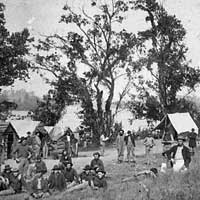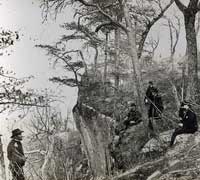About New Histories
.
Tuesday, 13 October 2015

History & Culture

Union Soldiers near Chattanooga, TN
Library of Congress
Through a series of skillful marches, Union General William S. Rosecrans forced Southerners under General Braxton Bragg to withdraw from Middle Tennessee to Chattanooga. Bragg dug in, guarding the Tennessee River crossings northeast of the city. However, early in September, Federals crossed the Tennessee well below Chattanooga, again forcing Bragg to withdraw southward. Eluding his Federal pursuers, Bragg concentrated his forces at LaFayette, Georgia, (26 miles) south of Chattanooga. Here reinforcements swelled his ranks to more than 66,000 men. Twice he unsuccessfully tried to destroy segments of Rosecrans' army. Then, on September 18, 1863, hoping to wedge his troops between the Federals and Chattanooga, Bragg posted his army on the west bank of Chickamauga Creek. Fighting began shortly after dawn on September 19. The armies fought desperately all day, but the Confederates eventually pushed the Federals back to the LaFayette Road. On September 20, Bragg again tried to drive between the Union force and Chattanooga, but failed to dislodge Rosecrans' line. Suddenly, a gap opened in the Federal ranks and Confederates smashed through, routing Rosecrans and half his army. General George H. Thomas took command of the remaining Federals and formed a new battleline on Snodgrass Hill. Here his men held their ground against repeated assaults. After dark, Thomas' forces withdrew from the field to the defenses of Chattanooga. The Confederates pursued and besieged the city. By placing artillery on the heights overlooking the river and blocking the roads and rail lines, the Southerners prevented Federal supplies from entering the city. 
General Grant (left) stands on Lookout Mountain.
Brooklyn Public Library
Within days of Grant's arrival in October, the situation began to change dramatically. Federal troops opened a supply route, nicknamed the "Cracker Line," from Bridgeport, Alabama. On November 23 Thomas' men attacked and routed the Confederates from Orchard Knob. On the 24th, aided by a heavy fog that enshrouded the slopes of Lookout Mountain, Hooker's soldiers pushed the Confederates out of their defenses. On November 25, with most of Bragg's army now concentrated on Missionary Ridge, Grant launched Sherman's troops against the Confederate right flank, and sent Hooker's men from Lookout Mountain to attack the Confederate left. Thomas' soldiers were sent to relieve the pressure on Sherman by assaulting the rifle pits at the base of Missionary Ridge. This was swiftly accomplished, but then, without orders, Thomas' men scaled the heights in one of the great charges of the war. The Confederate line collapsed and Bragg's troops fled to the rear, retreating into Georgia. The siege and battle for Chattanooga were over and Union armies now controlled the city and nearly all of Tennessee. The next spring, Sherman used Chattanooga for his supply base as he started his march to Atlanta and the sea.
Additional Resources:
|
Subscribe to:
Post Comments
(
Atom
)
No comments :
Post a Comment